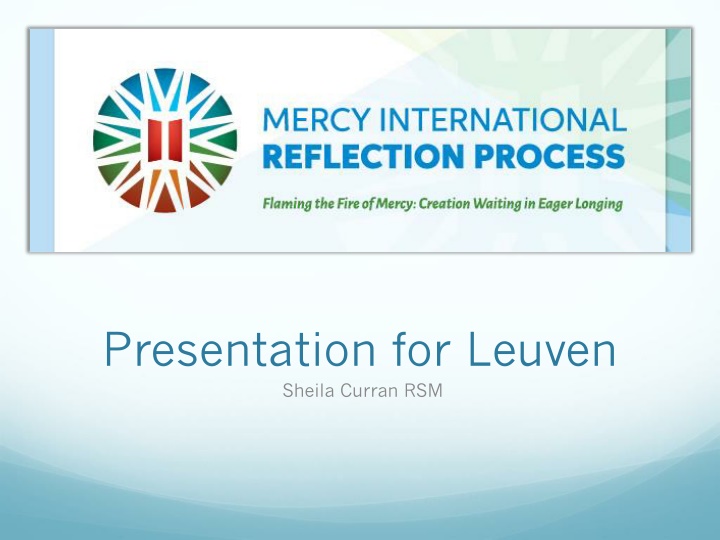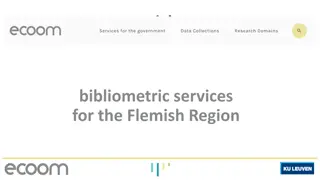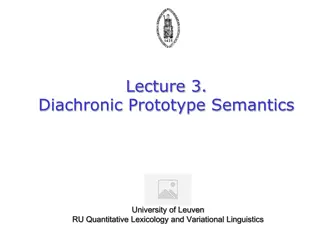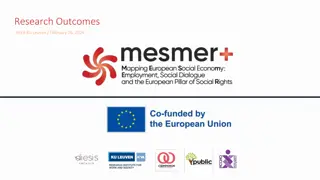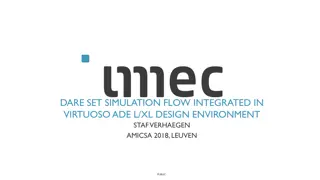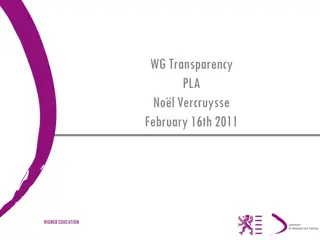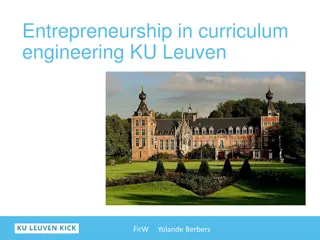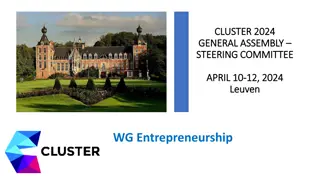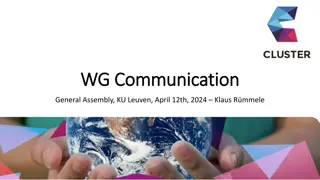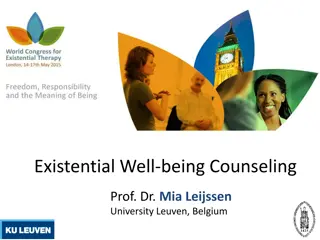Presentation for Leuven
Founded by Catherine McAuley in 1831 in Dublin, the Sisters of Mercy continue their mission of social justice and ecological justice across cultures and continents. With over 7,500 Sisters, 5,000 Associates, and millions of partners in ministry, they work towards a shared response to the cry of the Earth and the cry of the Poor. Pope Francis has affirmed and challenged their commitment to caring for both the environment and humanity, emphasizing the interconnectedness of all things.
Download Presentation

Please find below an Image/Link to download the presentation.
The content on the website is provided AS IS for your information and personal use only. It may not be sold, licensed, or shared on other websites without obtaining consent from the author.If you encounter any issues during the download, it is possible that the publisher has removed the file from their server.
You are allowed to download the files provided on this website for personal or commercial use, subject to the condition that they are used lawfully. All files are the property of their respective owners.
The content on the website is provided AS IS for your information and personal use only. It may not be sold, licensed, or shared on other websites without obtaining consent from the author.
E N D
Presentation Transcript
Presentation for Leuven Sheila Curran RSM
Sisters of Mercy Founded by Catherine McAuley in 1831 in Dublin
Mercy Today Diversity: 12 Congregations and Institutes sharing a common Mercy Charism, inserted in many cultures. Global Connections: Living and working across forty-four countries and six continents Indigenous sisters: Challenging us to look at what it meant by indigenous in our diverse realities Passion for Ministry: Rooted in Social Justice and Ecological Justice
We do not work alone 7,500 Sisters 5,000 Associates million partners in ministry Plus people who are partners-in-Mercy
Kairos moment MIRP Process was a journey. Flaming the Fire of Mercy: Creation Waiting in Eager Longing a process in a network of circles and in a contemplative space in which we discern together globally a shared response to the cry of the Earth and the cry of the Poor, thus flaming the fire of Mercy in us and in our Universe
Affirming Actions of Pope Francis March 2013 Pope Francis motto, Miserando atque Eligendo, gave us the new English word mercy- ing April 2015 Extraordinary Jubilee of Mercy: 8th December 2015-November 20th2016 June 2015 Encyclical on the environment and human ecology, Laudato Si, the first encyclical to focus on specifically on creation and human relationship with it.
Pope Francis Has challenged our world and our Church to hold together and attend to the cry of earth and the cry of the poor Everything is connected. Concern for the environment thus needs to be joined to a sincere love for our fellow human beings and an unwavering commitment to resolving the problems of society Everything is related.
The process Is not a new process but we are doing it in a new way as we engage members/associates/partners through out the Mercy World and we are participating in it together. It has been called by different names: Action/reflection/action See/judge/act Liberation process/ Most of all it is an organic process
Guiding Principles The urgency of the cry of the earth and All Earth s beings (human and other-than-human) and the cry of the poor. Mercy is at the heart of this cry and of this jubilee year. Contemplative prayer: it is the spirit that will guide all stages of the process. Cross cultural dimension: many cultures and cosmologies.
Guiding principles continued Diversity of expertise, age, culture, life experience, abilities, and beliefs. Participative process: including Partners-in-Mercy and Sisters. Sharing of resources. Communication: engage, inform, educate and unify.
Diagram of process Anne can you insert the diagram ???
Stage one The process begins where people are and comes out of their experience of engagement in the world. They will identify where they are hearing the cry of the earth and the cry of the poor. People are invited to bring their story/experience to a small group and share that experience. They will spend time and listen to each other to discover what are the key issues for this group. They will then decide what is the one issue they want to focus on at this time.
Stage 2 The group will now have its focus issue. They will be invited to deepen their knowledge of this issue and bring it to a broader context. Use poetry, literature, images, range of the sciences, etc. Materials are provided to assist the groups including material from our global contexts. The level of engagement and format will differ from group to group. Information will be shared with the other groups participating in the process.
Stage 2 The importance of bringing critical questions to the context for example: How is power organised? Political and Religious? How are resources being distributed? Gender issues? How does this issue/problem impact on the poor? How does it impact on our earth?
Stage 3 Bringing questions, issues from stage 2 into dialogue with our sacred traditions. Asking new critical questions of our sacred traditions in relation to the cry of the earth and the cry of the poor. How and where does the text enable us to hear cry of earth and the cry of the poor. The need to engage anew: prophetic engagement. This will lead to a new vision and praxis
Between stage 3/4 The groups will take time to articulate the vision that is beginning to emerge in the group. The vision that is emerging is in a particular context and each context is different. The vision in turn will lead us to new ways of engaging in mercy.
Stage 4 This stage moves people in to action. How are we called to act differently at the end of this process? Actions need to be articulate clearly. It is not just new action , but action profoundly informed by reflection. Mercy-ing is a doing word. Spiral not a circular process.
Diagram of process Anne can you insert the diagram ???
Key elements Beginning with the lived experience. Diversity. Inclusion: Every single voice counts Interpretation: 44 countries different contextual theologies Change: Hermeneutics that does not effect change is not hermeneutics. E. Schussler Fiorenza Transformation: this always includes loss.
